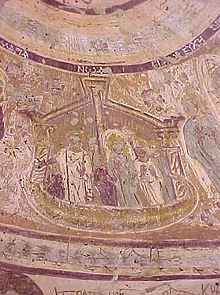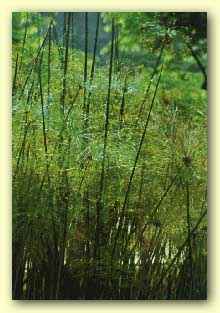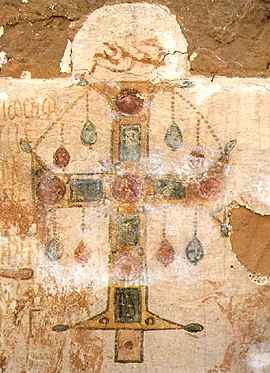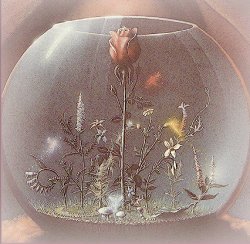 Oxyrhynchus
is an archaeological site in Egypt, one of the most important ever
discovered. For the past century the area around Oxyrhynchus has
been continuously excavated, yielding an enormous collection of
papyrus texts from the Hellenistic, Roman and Byzantine periods
of Egyptian history.
Oxyrhynchus
is an archaeological site in Egypt, one of the most important ever
discovered. For the past century the area around Oxyrhynchus has
been continuously excavated, yielding an enormous collection of
papyrus texts from the Hellenistic, Roman and Byzantine periods
of Egyptian history.
We know more about Oxyrhynchus as a city, and about its people as
living individuals, than we do about many more glamorous and famous
historic ruins because because of one thing: the town garbage dumps.
These remained intact right up to the late nineteenth century, as
they were not considered likely sites for treasure-hunters. They
have yielded the largest collection of ancient papyrus ever discovered.
Among the texts discovered at Oxyrhynchus are plays of Menander
and the Gospel of Thomas (an important early Christian document),
and the oldest known music notation and lyrics of a
Christian hymn.
 The
Greek language flourished in Egypt for a thousand years. It first
began to be widely spoken there when the country was conquered by
Alexander the Great, who founded Alexandria in 331 B.C. and then
set off to extend his empire in the East.
The
Greek language flourished in Egypt for a thousand years. It first
began to be widely spoken there when the country was conquered by
Alexander the Great, who founded Alexandria in 331 B.C. and then
set off to extend his empire in the East.
 For
all this time in every part of the Greek-speaking world books and
documents were written on a paper made from the papyrus
reed, which was rare outside Egypt, and even there died
out in about the tenth century A.D. It is now to be found chiefly
in the Sudd, a vast area of swamp in the Sudan covered with thickets
of papyrus.
For
all this time in every part of the Greek-speaking world books and
documents were written on a paper made from the papyrus
reed, which was rare outside Egypt, and even there died
out in about the tenth century A.D. It is now to be found chiefly
in the Sudd, a vast area of swamp in the Sudan covered with thickets
of papyrus.
In Hellenistic times Oxyrhynchus was a prosperous regional capital,
the third largest city in Egypt. After Egypt was converted to Christianity,
it was famous for its many churches and monasteries. It remained
a prominent, though gradually declining, town in the Roman and Byzantine
periods. After the Arab conquest of Egypt in 641, the canal system
on which the town depended was allowed to fall into disrepair, and
Oxyrhynchus was abandoned. Today the town of el-Bahnasa occupies
part of the ancient site.
 For
a thousand years the inhabitants of Oxyrhynchus dumped their rubbish
at a series of sites out in the desert sands beyond the town limits.
The fact that the town was built on a canal rather than on the Nile
itself was important, because this meant that the area did not flood
every year with the rising of the river, as did the districts along
the riverbank. When the canals dried up, the water table fell and
never rose again. The area west of the Nile has virtually no rain,
so the rubbish dumps of Oxyrhynchus were gradually covered with
sand and lay, dry, sterile and forgotten, for another thousand years.
For
a thousand years the inhabitants of Oxyrhynchus dumped their rubbish
at a series of sites out in the desert sands beyond the town limits.
The fact that the town was built on a canal rather than on the Nile
itself was important, because this meant that the area did not flood
every year with the rising of the river, as did the districts along
the riverbank. When the canals dried up, the water table fell and
never rose again. The area west of the Nile has virtually no rain,
so the rubbish dumps of Oxyrhynchus were gradually covered with
sand and lay, dry, sterile and forgotten, for another thousand years.
Because Egyptian society under the Greeks and Romans was governed
bureaucratically, and because Oxyrhynchus was a regional capital,
the material at the Oxyrhynchus dumps included vast amounts of paper.
Accounts, tax returns, census material, invoices, receipts, correspondence
on administrative, military, religious, economic and political matters,
certificates and licenses of all kinds — all these were periodically
cleaned out of government offices, put in wicker baskets, and dumped
out in the desert. Private citizens added their own piles of unwanted
paper. Because papyrus was expensive, paper was often re-used: a
document might have farm accounts on one side, and a schoolboy's
text of Homer on the other. The Oxyrhynchus papyri thus contained
a complete record of the life of the town, and of the civilizations
of which the town was a part.
The recovery of papyri began in the middle of the eighteenth century,
when the remains of a Greek library on papyrus rolls were found
in Italy at Herculaneum, preserved by the debris of an eruption
of Vesuvius. By the end of the eighteenth century a few papyri had
been discovered in Egypt, the country whose dry climate is most
favorable to their survival, and the number slowly grew. By the
eighteen-nineties exciting finds of Greek literature, lost works
by such authors as Aristotle and Hyperides, encouraged the Egypt
Exploration Fund (later Society) to commission excavations specifically
in search of papyri. In their second season, in 1896/7, B. P. Grenfell
and A. S. Hunt, two young fellows of Queen’s College, Oxford,
found the site that was to produce the largest collection of all
— Oxyrhynchus.
including the music of the spheres, the music of a Renaissance alchemist, music created by software and artificial intelligence, the music of the fairies, the music of the Illuminati, the world's most mysterious book, the world's oldest song, a way you can compose music like Mozart, the world's oldest love song,

 The
Greek language flourished in Egypt for a thousand years. It first
began to be widely spoken there when the country was conquered by
Alexander the Great, who founded Alexandria in 331 B.C. and then
set off to extend his empire in the East.
The
Greek language flourished in Egypt for a thousand years. It first
began to be widely spoken there when the country was conquered by
Alexander the Great, who founded Alexandria in 331 B.C. and then
set off to extend his empire in the East.  For
all this time in every part of the Greek-speaking world books and
documents were written on a paper made from the papyrus
reed, which was rare outside Egypt, and even there died
out in about the tenth century A.D. It is now to be found chiefly
in the Sudd, a vast area of swamp in the Sudan covered with thickets
of papyrus.
For
all this time in every part of the Greek-speaking world books and
documents were written on a paper made from the papyrus
reed, which was rare outside Egypt, and even there died
out in about the tenth century A.D. It is now to be found chiefly
in the Sudd, a vast area of swamp in the Sudan covered with thickets
of papyrus. For
a thousand years the inhabitants of Oxyrhynchus dumped their rubbish
at a series of sites out in the desert sands beyond the town limits.
The fact that the town was built on a canal rather than on the Nile
itself was important, because this meant that the area did not flood
every year with the rising of the river, as did the districts along
the riverbank. When the canals dried up, the water table fell and
never rose again. The area west of the Nile has virtually no rain,
so the rubbish dumps of Oxyrhynchus were gradually covered with
sand and lay, dry, sterile and forgotten, for another thousand years.
For
a thousand years the inhabitants of Oxyrhynchus dumped their rubbish
at a series of sites out in the desert sands beyond the town limits.
The fact that the town was built on a canal rather than on the Nile
itself was important, because this meant that the area did not flood
every year with the rising of the river, as did the districts along
the riverbank. When the canals dried up, the water table fell and
never rose again. The area west of the Nile has virtually no rain,
so the rubbish dumps of Oxyrhynchus were gradually covered with
sand and lay, dry, sterile and forgotten, for another thousand years.

